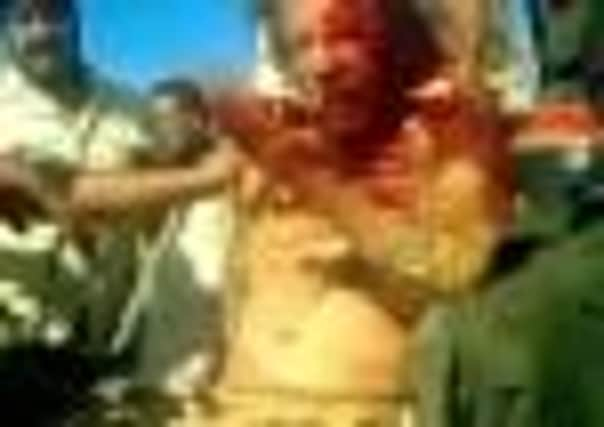Even in death, Gaddafi causes conflict


Grisly footage has emerged of the dead dictator lying on a yellow mattress inside a shopping centre chiller room, where dozens of chanting men are seen taking mobile-phone pictures of his battered body.
Hundreds of Libyans jostled to get inside, chanting: “We want to see the dog”, as the interim government said his funeral was being delayed while the exact circumstances of his death were investigated.
Advertisement
Hide AdAdvertisement
Hide AdThe United Nations and human rights groups have demanded a full investigation amid concerns Gaddafi was the victim of a war crime. Although Gaddafi was wounded when he was captured, there have been contradictory accounts of how he died, raising questions over whether he was shot while in custody, something Libyan officials have denied.
Under Islamic tradition, burials should take place as soon as possible, but Libya’s oil minister, Ali Tarhouni, said the body was likely to remain in cold storage for several days. The authorities are likely to want to avoid the risk of a revenge attack and are thought to be considering burying him at sea, as was Osama bin Laden, to prevent any grave being turned into a shrine.
Gaddafi’s body was taken from his home city of Sirte, where he was captured after being found cowering inside a huge drainage pipe, to Misrata, home of the fighters who captured the ousted leader on Thursday.
Former rebel commander Abdul-Salam Eleiwa said: “I expect he will be buried in a Muslim cemetery within 24 hours. He will get his right like any Muslim; his body will be washed and treated with dignity.”
The footage from the freezer showed Gaddafi stripped to the waist, with bullet holes visible on the left side of his head, where the bullet was still lodged, and in the centre of his chest and stomach, according to a doctor.
Images filmed on mobile phones showed him first wounded and bloodied but clearly alive after his capture, and then dead amid a crowd of anti-Gaddafi fighters.
UN human rights spokesman Rupert Colville said: “There’s a lot of uncertainty about what happened exactly. There seem to be four or five different versions of how he died.
“We feel that it is very important that this is clarified, that there is some sort of serious investigation into what happened and what caused his death.”
Advertisement
Hide AdAdvertisement
Hide AdUnder the Geneva Conventions, which lay down the rules of conduct in armed conflict, it is prohibited to torture, humiliate or murder detainees.
Libya’s interim prime minister, Mahmoud Jibril, has insisted that Gaddafi was killed in “crossfire” while being taken to hospital after his capture.
However, Peter Bouckaert, of the campaign group Human Rights Watch, said the organisation did not think that this was the case.
“We are calling for an autopsy and an investigation. This is a blemish on the new Libya.”
Footage has also emerged of Gaddafi’s dead son, Mutassim, after he was captured in Sirte, sitting up and smoking a cigarette and drinking a bottle of water.
The events leading up to his death are also unclear. A military source in Misrata would confirm only that he was shot in the neck and killed. Libyan officials claimed last night that Gaddafi’s favourite son, Saif al-Islam, had been captured near Tripoli after suffering critical injuries in a bombing raid.
Meanwhile, Libya’s new leaders will have to dig deep to find billions of dollars in cash and assets that Gaddafi and his family stashed around the world, and then will face daunting legal hurdles to recover them all.
Analysts believe $19 billion (£12bn) in assets thought to have been under the control of Gaddafi or associates have been located and frozen by the UN and member countries.
Advertisement
Hide AdAdvertisement
Hide AdBut other estimates suggest Gaddafi controlled as much as $30bn in the US, plus large holdings in Europe and South Africa.
Victor Comras, a former money-laundering expert for the US state department, said: “Gaddafi was no dummy. The obvious and easy money, held in western banks and financial institutions, has largely already been located and blocked.”
He added that Gaddafi “likely also squirreled away large sums in assumed names or secret numbered accounts, or lockbox/deposit box stashes of currency, precious metals and marketable art and collectibles”.
Other assets could include indirect shareholdings held under assumed names.